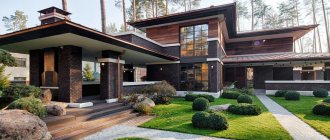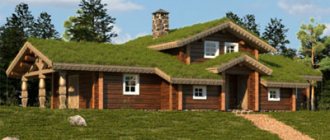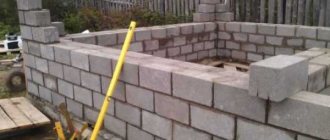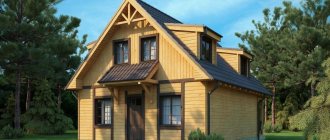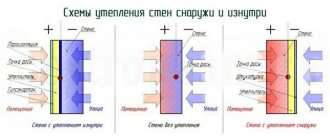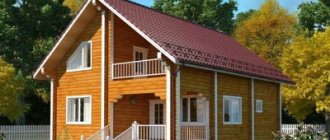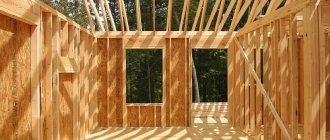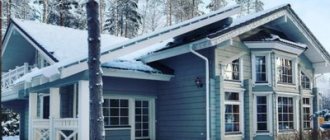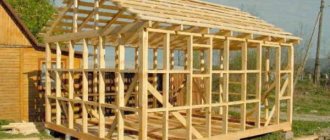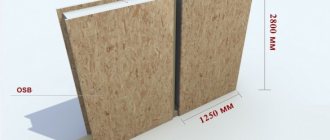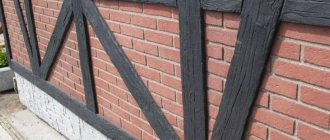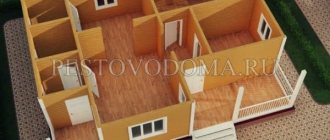The most important question when choosing aerated concrete is how aerated concrete will retain heat in the house. The density of the blocks and their thickness are responsible for this. Next, you need to decide on the strength of the blocks that is required for the building according to the project, and after that you decide with the manufacturer.
We will now describe the following issues in detail:
- Autoclaved or non-autoclaved aerated concrete?
- What thickness and height are the blocks?
- What density?
- Which manufacturer to choose.
- Which blocks to choose for partitions.
- Flat blocks or with a tongue-and-groove system.
Characteristics of foam block
Foam block is a porous building material with good thermal insulation properties
Porous building material has become popular due to its excellent thermal insulation characteristics and affordable cost. Foam concrete block is one of the types of stones made of lightweight cellular concrete. Its technical characteristics and properties are determined by the manufacturing features.
Production technology
The classic composition for foam concrete is cement, sand and water. To create a porous structure, a foam mixture of synthetic or organic foaming agents is prepared separately. When mixing the components, air cells are formed inside the foam concrete. To save cement, ash, clay and other fine materials are added to the solution. Foam blocks are produced by hardening and gaining strength in molds or by cutting the monolith into individual stones.
- Thermal conductivity coefficient - the parameter depends on the number of air cells; the more there are, the better the protection from the cold. The coefficient is 0.1-0.38.
- Density - the number of pores determines the ratio of the weight of the material to its volume. Low density reduces weight and improves insulating properties, but at the same time strength decreases.
- Frost resistance - the average is 25 cycles of freezing and thawing; there are brands with lower and higher frost resistance (from 15 to 75 cycles).
- Weight – the parameter depends on the density, the smallest is 8.5 kg, the maximum is 47 kg.
The typical size of a foam block for building a house is determined by technical conditions. The variety of dimensions is small, common options:
- 100x300x600 mm – semi-block for partitions;
- 300x200x600 – for interior walls;
- 200x400x600 mm – for load-bearing walls.
The thermal conductivity index of the material is calculated for the stone in dry form. As humidity increases, it decreases.
Advantages and disadvantages of the material
Foam blocks have many positive qualities that have made them popular:
- Low thermal conductivity - in terms of energy efficiency, housing is comparable to buildings made of wood; the indicator significantly exceeds the characteristics of reinforced concrete and brick.
- Light weight - the total weight of the house allows you to build a light foundation, saving money on the foundation.
- Sound insulation - air pores in the stone absorb acoustic waves well.
- Fire resistance - the blocks do not burn and ensure the fire safety of the building.
- Environmentally friendly - the material and masonry mortar contain safe components that do not harm health.
- Affordable cost - building materials are offered at a low price, which reduces the overall cost of building a house.
Cellular concrete is easy to process; it can be easily cut, drilled, and tapped. The dimensions of the blocks speed up the construction of walls and reduce labor costs.
- Natural shrinkage - the process of concrete gaining strength is associated with shrinkage, it is 2-4 mm per linear meter.
- An uneven surface is a minus characteristic of material made by molding.
- Insufficient strength - the stone is not intended for high loads; most brands are only suitable for the construction of houses up to three floors. The porous structure causes difficulties with the reliability of fasteners.
The material has an unpresentable appearance, the blocks are gray and porous. After the construction of the building, external cladding is required.
Top 10 manufacturers
The building materials market offers a wide selection of gas blocks from different manufacturers.
Xella
The Xella company is a large manufacturer of building materials, which is based in Germany, but has enterprises in the Russian Federation. It produces modern series of aerated concrete, which are sold not only in Russia, but also in foreign countries.
Over the years of its existence, the brand has won the trust of thousands of consumers, since advanced technologies and innovative developments are used in the production process of blocks.
EuroAeroBeton
EuroAeroBeton has been producing aerated concrete blocks since 2008. The production is located in the Leningrad region. The brand’s engineers use the best modern technologies that allow the development of aerated concrete on an industrial scale.
This became possible due to automated equipment from leading European, Japanese and American companies. The quality of our products is controlled by our own laboratories.
Voronezh Construction Materials Plant
The third position in the ranking of the best producers of aerated concrete is occupied by the Voronezh Construction Materials Plant. The company appeared on the Russian market 55 years ago; current production volumes reach 140 million bricks per year.
Advanced systems and equipment are used in production. At the same time, the manufacturer is constantly modernizing its factories, which ensures high quality products.
LSR
In 4th place on the list is the LSR brand. Construction-Ural". It belongs to the largest LSR group, which produces a wide range of building materials, including aerated concrete blocks. The history of the brand began 50 years ago. The company's factories use advanced equipment from Germany, which increases production rates and ensures better quality indicators.
KZSST
5th place in the ranking belongs to the KZSST enterprise (Kazan Plant of Silicate Wall Materials). The company occupies a leading position in terms of sales volumes in the Republic of Tatarstan and the entire Volga region. Production figures reach 230 million bricks and 100 thousand cubic meters. m. autoclave-type gas blocks. The brand's assortment includes face bricks in 10 colors and different options for aerated concrete blocks.
Lipetsk silicate plant
The 6th position is occupied by the Lipetsk Silicate Plant, which is included in the ranking of the 100 best producers of silicate blocks. The enterprise was founded in 1938. Today, the company’s products are bought not only in the Lipetsk region, but also in other parts of the Russian Federation. In 2012, the manufacturer was certified ISO 9001:2008, which is a guarantee of high quality.
Glavnovosibirskstroy
Glavnovosibirskstroy is another popular manufacturer of building materials that entered the market in 1963. The holding consists of a number of companies engaged in the production and sale of gas silicate blocks with good performance characteristics.
Over the entire period of operation, the company has sold more than 13 million square meters. m of residential facilities and 500 industrial facilities. Several years ago, the holding set a goal to increase production volume; the annual capacity is now 360 cubic meters. m. per year.
PESP
PESP (Perm Silicate Panel Plant) is one of the leaders of the local market and produces gas blocks with different parameters. The company employs more than 5 thousand people, and its main area of activity is the implementation of various projects for the construction of buildings for various purposes. The company's products are characterized by increased strength, resistance to heavy loads and low thermal conductivity.
Saratov building materials plant
Took 9th place. In 2001, the holding received the “Golden Standard” award, confirming the reliability of the brand. The production process uses advanced equipment and many years of experience of leading engineers.
Comparison of foam block with gas block
Aerated concrete blocks and foam blocks are types of lightweight cellular concrete that have a porous structure. The materials have similar characteristics in terms of thermal conductivity (0.1-0.4 W/m*K), fire resistance, density (300-1200 kg/m3) and biological inertness. The main difference between the blocks is strength. Gas silicate is produced by autoclave under high temperature and pressure. This technology provides excellent compressive strength.
Foam blocks dry naturally, they shrink slightly (up to 3 mm), have an uneven surface and dimensional errors of up to 5 mm. Aerated blocks are distinguished by their clear geometry and smooth surface. The advantages of foam block include a lower percentage of water absorption.
Strength classes
There are several classes of aerated concrete in terms of strength.
They determine the ability of the material to withstand loads and indicate the areas of its application:
- B1.5 - suitable for the construction of houses with 1-1.5 storeys.
- B2 - for houses with 1.5 and 2.5 storeys.
- B2.5 - designed for buildings with two and three floors.
- B3.5, B5 - durable material that is used in the construction of buildings up to 5 floors.
Types of foam blocks for building a house
Types of material are classified according to several indicators.
Products are produced with different densities ranging from 300 to 1200. This characteristic determines the thermal insulation and strength qualities of the blocks. The following brands of building materials are distinguished:
- thermal insulation – D300-D500, weight 11-19 kg, used for insulation of internal non-load-bearing structures;
- structural and thermal insulation – D600-D900, weight 23-35 kg, suitable for building houses with one or two floors;
- structural - D1000-D1200, weight 39-47 kg, has the highest thermal conductivity (0.36-0.4 W/m*K), used for laying load-bearing walls, foundations and plinths.
- sliced - the raw mass is cut with metal strings, the product has clear dimensions;
- molding - made in molds with partitions, less durable, but cheaper material;
- reinforced - polymer or basalt fiber, glass fiber (up to 1% of the volume) are added to the composition, enhancing the strength characteristics of the blocks.
- wall - the most durable products for the construction of external enclosing structures;
- partition – small block 100x300x600 mm;
- non-standard – products are manufactured according to customer requirements.
Making building materials at home has become a common practice. The simplicity of production technology and the availability of equipment make it possible to create a profitable business. When purchasing foam concrete, you should check the quality certificates for the product.
Selection rules
There should be no cracks or chips on the blocks
If porous artificial stone is chosen as a material for the walls in a house project, then you should decide on its purpose. For load-bearing walls, large-sized products of high and medium density D600-D1200 are used. Partitions and unloaded structures can be erected from a material of lower density, it will cost less.
When choosing which foam block is best to build a private house from, evaluate its external parameters:
- homogeneity of structure, uniform distribution of pores (checked in section);
- size and weight - the block can be measured and weighed to determine compliance with the stated figures;
- uniform coloring, a light shade indicates low quality of the product;
- There should be no cracks or chips on the stones.
When purchasing, pay attention to the frost resistance of the blocks; if construction takes place in a warm region, then an average indicator is sufficient. Housing in cold areas needs a material with a cycle rate of 50-75. Low cost of products attracts buyers, but it may mean a violation of technology and the use of poor quality raw materials. You also need to find out the time of production of a batch of blocks. They must lie for at least a month to gain strength.
Transportation and storage of aerated concrete blocks
To maintain the quality of the material and get a good-quality home, manufacturers recommend following the rules for loading and unloading, transporting and storing aerated concrete.
- When delivered from the factory, the blocks are packaged in translucent film to protect them from precipitation and transported on wooden pallets.
- For transportation, each row of pallets is secured with special textile straps to protect them from tilting, moving around the body and damage.
- The upper pallets are protected with special plastic corners.
- Aerated concrete is unloaded only 1 pallet at a time and preferably onto a finished foundation, concrete, asphalt or reinforced concrete covering.
- Aerated blocks are stored in 1 tier on a level area.
If packaging defects and chips are noticed on the blocks, this is grounds for replacing the product.
Aerated concrete is a reliable material for construction if all rules and technologies are observed.
Process of working with foam block
To calculate the required amount of material, take into account its standard size, length and height of the walls. The masonry is usually done using one stone, but the thickness of the walls is not energy efficient enough. Insulation is carried out with thermal insulation slabs of mineral wool. The type of foundation depends on the geological features of the site, but most often a strip or slab foundation is chosen.
Stone laying is done using cement-sand mortar. The use of adhesive mixtures reduces heat loss, but due to the uneven surface of the blocks, their use is not recommended. Another difficulty is the insufficient strength of the fasteners. Dowels and anchors designed for porous concrete should be used.
When constructing a building, it is necessary to provide reinforcement. The laying of metal rods is carried out starting from the first row, every four. It is also installed in window and door openings. Furrows are sawn in the blocks for the reinforcement, which are filled with adhesive solution. It is possible to use plastic or metal mesh; in this case, there is no need to groove the blocks. Reinforcement will prevent cracking of the walls during shrinkage.
Hygroscopic cellular concrete accumulates moisture, so after construction of housing, external finishing is necessary. A suitable option is plastering followed by painting, installation of siding, and cladding with artificial stone. Finishing begins 3-4 months after the house is built. It takes time to shrink.
A house made of foam concrete blocks can be built in a short period of time and is warm and durable. The porous material provides a favorable microclimate and protects from street noise. When deciding which foam block to choose for building your home, it is important not to skimp on strength and contact a trusted manufacturer.
Source
Gas block for partitions
Since aerated concrete has good performance properties, it is actively used in the construction of partitions for zoning the space of rooms. The construction of such structures begins only after the completion of the construction of the external walls.
If the length of the partitions exceeds 8 m and the height is 3.5 m or more, they will have to be additionally reinforced with reinforcing elements. When choosing a thickness, you need to make sure that it can ensure the stability of the wall. Increased strength properties and reliability are ensured by a high-quality layer of cement 1-3 mm thick.
To reduce the pressure on the aerated concrete partition, expansion joints are provided. Their height reaches 20 mm, and the internal space is filled with mineral wool, polyurethane foam or other materials with shock-absorbing properties. Using a similar principle, the edges of the partition are connected to load-bearing objects. The partition is connected to the wall using reinforced concrete structures.
How to choose a suitable foam block
First of all, you need to decide what size blocks you need. If the masonry is carried out independently, then large-format blocks will not be suitable, because 1-2 people cannot handle them.
For example, when I built a house from foam blocks, there was no need to use a block larger than 20*30*60 cm.
In answer to the question “which foam blocks are best to build a house from” it is difficult to give a definite answer. The thing is that the usual M marking is not used in relation to this material. Unlike brick, for example, the brand of foam block does not indicate its strength, but its density.
That is, looking at the number after the letter M in the brand of brick, you can understand how many kg per unit area it can withstand. In foam concrete, markings are carried out with numbers from 400 to 1200 after the letter D.
The number tells how many kilograms a cubic meter of brick weighs. Pay close attention to the photo below. The price, as you understand, will increase in proportion to the increase in brand.
If you take this point into account in your foam block house project, you will save yourself from unnecessary hassle, and you will not have to invest in subsequent repairs.
As you understand, it is impossible to say which foam blocks are better in principle. It is necessary to understand that each has its own use and use it correctly.
Why foam block
First of all, let us remind you: do not confuse foam concrete with aerated concrete. One of the articles on our website discusses in detail the fundamental differences between these two materials. It is worth noting that the price of foam concrete is more favorable.
What he really is
A foam block is a small “block” made by mixing a concrete mixture with special foaming components. It is the foam that forms cavities in the concrete, which reduce its weight and increase its thermal insulation parameters.
Its standard size is 200*300*600 mm. For clarity, look at the photo below and imagine how to build a house from foam blocks quickly and easily, in comparison with the same brick.
Houses made of this material cost significantly less than houses of the same size made of brick or, for example, timber. And if you are not lazy and build everything yourself, then the savings will exceed even your wildest expectations.
Having an attractive price, foam block houses are in no way inferior in their parameters to stone or wooden ones. Another attractive feature of the material is its environmental friendliness.
Advantages of the material
- No additives that negatively affect human health are used in production, which makes it possible to build children’s or health complexes from it . With such a construction, considerable attention is paid to sound insulation - and foam concrete has no equal in this regard.
- The structure of the material itself is favorable for further processing . With the help of simple tools you can give the block any desired shape.
- The porous structure does not interfere with gas exchange and the house “breathes” no worse than a wooden one.
- From the previous point it logically follows that such a house is not characterized by excessive humidity and dampness . With foam concrete you will forget about mold and drips.
- Not only the size, but also the principle of laying will help save time and mortar . After all, the gap between the blocks should not exceed 3 mm.
- Both exterior and interior decoration will also not cause you unnecessary trouble, because the layer of plaster does not have to be thick at all.
- Foam concrete has excellent fire resistance . At high temperatures, the material does not crumble or crack and protects the reinforcement from heating. In the event of force majeure, such a house will not let you down.
Facade finishing
Since you are building a house, this means that you, first of all, want comfortable living conditions for yourself and your family. The appearance of the house is an important component of comfort, so the surface of the walls must be finished from the outside, otherwise the house will darken and turn into a “gloomy castle.” Moreover, the aesthetic component is not the main reason for the need for external work; finishing enhances the parameters of foam concrete, the house becomes stronger and warmer, and moreover, sound insulation characteristics increase.
Exterior decoration of the house
There are several ways to decorate a foam block house:
- Decorative panel. It is necessary to leave an air gap between the walls and hanging cladding.
- Mixtures that are used as concrete plaster.
- Stones or bricks for finishing.
- Painting with silicone, waterproof and steam-resistant paint.
As for the interior decoration, here “there are no comrades according to taste and color” - the interior design depends solely on your taste and imagination.
Progress
Now, after we have answered the main question posed in this article, let’s move on to a secondary one, namely: how to quickly build a house from foam blocks.
Of course, this is just a general diagram of how to build a house from foam blocks; in order to create a complete one, you need to know the nuances of a specific project.
And it looks like this:
- The first step is to build a foundation for a foam block house. Since the foam block is lightweight, there is no need to spend money on an expensive monolithic foundation. An excellent replacement for it can be a belt one, which uses much less crushed stone, sand, concrete, and even uses reinforcement of a smaller diameter.
- After the base has gained the required strength, it is time for laying. It starts with laying roofing felt between the base and the first row as waterproofing.
- The corner blocks are laid first. Moreover, special attention is paid to the corner, which according to the plan will be the highest. The corner is leveled and proceed to the next one.
- then a cord is pulled over the corners and the space between them is filled. If a whole block does not fit in one of the rows, then the excess part is cut off and the resulting piece is placed in the gap.
- Each next row is installed according to the same principle: from the corners. Verticals and horizontals are checked by level and cord.
Advice! Remove possible unevenness immediately with a plane.
- To prevent the walls from cracking during shrinkage, the masonry must be reinforced. Reinforcement with a diameter of 8 mm is placed in pre-cut grooves measuring 4 by 4 cm, which after installation are filled with glue or mortar.
Advice! It is recommended to reinforce the first and second rows, and then every 4-5 rows of masonry.
- Electrical wiring is also laid in grooves according to the same principle, but the laying pattern depends on the specific project.
- Particular attention is paid to door and window openings. All cut grooves are lined flush with a metal corner.
- Another little tip: to cut the blocks you need to use a special hacksaw for foam concrete with large teeth. If you cut correctly, you will avoid crumbling of the material.
- For interior decoration, drywall, boards and textured plaster are excellent options. It’s even easier on the outside - use siding or finishing bricks.
This instruction tells only in general terms how to build a house from foam blocks. For more detailed information, take a few minutes to watch the video in this article.
